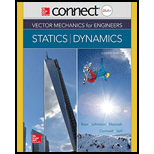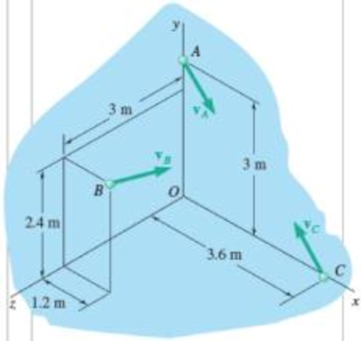
Concept explainers
For the system of particles of Prob. 14.13, determine (a) the position
Fig. P14.13

(a)
Find the position vector of the mass center of the system.
Answer to Problem 14.14P
The position vector of the mass center of the system is
Explanation of Solution
Given information:
The mass of the particles A is
The mass of the particles B is
The mass of the particles C is
The position vector is
The mass center is G.
Calculation:
Find the position vectors from point O to each satellite in meters.
Refer to figure P14.13 in the textbook.
Express the position vector point A as follows:
Express the position vector point B as follows:
Express the position vector point C as follows:
Determine the mass center G of the system using the relation:
Here,
Substitute
Thus, the position vector of the mass center of the system is
(b)
Find the linear momentum of the system.
Answer to Problem 14.14P
The linear momentum of the system is
Explanation of Solution
Calculation:
Express the linear momentum of particle A as follows:
Express the linear momentum of particle B as follows:
Express the linear momentum of particle C as follows:
Find the linear momentum of the system using the relation:
Substitute
Thus, the linear momentum of the system is
(c)
Find the angular momentum of the system about G and also verify this problem and to problem 14.13 satisfy the Equation given in problem 14.27.
Answer to Problem 14.14P
The angular momentum of the system about G is
Explanation of Solution
Calculation:
Find the position vector from the particles
Here,
Substitute
Find the position vector from the particles
Here,
Substitute
Find the position vector from the particles
Here,
Substitute
Calculate the angular momentum about point G using the relation:
Here,
Substitute
Thus, the angular momentum of the system about G is
Find the value of
Substitute
Show that the
Express the angular momentum about point O as follows:
Substitute
Hence, the
Want to see more full solutions like this?
Chapter 14 Solutions
Connect 2 Semester Access Card for Vector Mechanics for Engineers: Statics and Dynamics
- Determine the altitude reached by the spacecraft of Prob. 14.95 when all the fuel of its launching rocket has been consumed.Reference to Problem 14.95:A 540-kg spacecraft is mounted on top of a rocket with a mass of 19 Mg, including 17.8 Mg of fuel. Knowing that the fuel is consumed at a rate of 225 kg/s and ejected with a relative velocity of 3600 m/s, determine the maximum speed imparted to the spacecraft if the rocket is fired vertically from the ground.arrow_forwardA billiard player sends the cue ball toward a group of three balls that are initially at rest and in contact with one another. After the cue ball strikes the group, the four balls scatter, each traveling in a different direction with different speeds as shown in the figure below. If each ball has the same mass, 0.16 kg, determine the total momentum of the system consisting of the four balls immediately after the collision. (Assume v1 = 0.33 m/s, θ1 = 70°, v2 = 0.49 m/s, θ2 = 30°, v3 = 0.21 m/s, v4 = 0.48 m/s.) magnitude ? (in kg m/s^2) direction ? (in degrees counterclockwise from the + x-axis)arrow_forwardConsidering a glancing collision between a cue ball of mass m moving at initial velocity u and a target ball of the same mass initially at rest. This results in a two-dimensional collision with the cue ball's final velocity v making an angle θ with the target ball's final velocity w. Show explicitly that the collision is elastic if and only if θ = π/2 = 90°.arrow_forward
- Conservation of Linear Momentum for a System of Particles Two spheres A and B (of mass m each) were fired vertically from the ground with different initial velocities at different times. When sphere A reached its summit, sphere B, with an upward velocity of 17 m/s, created a head on collision with A. The impact caused sphere A to break into two pieces, each of mass m/2. Knowing one piece reached Point C and the other piece reached point D after the collision, determine (a) the velocity of sphere B after the collision; (b) the angle and the speeds of the two pieces after the collision; and (c) the force exerted by sphere A on B if the collision occurred in 0.001 s.arrow_forwardThe two spheres shown collide. the weight of the first sphere (W1) is 40 N while that of the second is (W2) is 30N. assuming that the second sphere's velocity (v2) is 14 m/s and the first sphere's velocity (v1) is 16 m/s along the their respective angles. theta 1(θ1)=30 degrees and theta 2(θ2)=60 degrees. Assume velocities along y will be equal before and after impact. The coefficient of restitution is 0.57. A.) Determine the velocity of the 30N sphere after impact (m/s) B.) Determine the Velocity of the 40N sphere after impact (m/s) C.) Determine the angle of the velocity after impact of the 40N sphere with the horizontal (degrees) D.) Determine the angle of the velocity after impact for the 30N sphere with the vertical (degrees)arrow_forwardA 2-kg model rocket is launched vertically and reaches an altitude of 70 m with a speed of 30 m/s at the end of powered flight, time t= 0. As the rocket approaches its maximum altitude it explodes into two parts of masses mA = 0.7 kg and mB = 1.3 kg. Part A is observed to strike the ground 80 m west of the launch point at t = 6 s. Determine the position of part B at that time.arrow_forward
- Situation 01. A 4kg ball and 3kg ball move on a smooth plane along a straight path with speeds equivalent to 6m/s going to the right and 8 m/s going to the left, respectively a. Determine the speed of the 3kg ball after impact if the impact is elastic. b. Determine the speed of the 3kg ball after impact if the coefficient of restitution is 0.50. complete solution of impulse and momentumarrow_forwardA particle of momentum P1 collides with a particle at rest. After the collision, the particle initially at rest decays into two particles of momentum P3 and P4, respectively, while particle 1 continues in a straight line with momentum P1'. Knowing the magnitudes of all the momentum listed above and knowing that energy was not conserved during the process, find the angle θ (theta) between particles 3 and 4.arrow_forward(a). Two identical blocks A and B are at rest on a frictionless plane. Block C of the same weight hits block B with a velocity of 2.5 m/s. Knowing that the coefficient of restitution is 0.7 between block B and block C and 0.4 between block A and block B. (i) Determine the velocity of each block after all collisions have taken place. (ii) From your working in Q1(a)(i), predict whether there will be another collision after block B collides with block A? (iii) If the coefficient of restitution between block A and block B is changed to 0.7, explain with calculations whether there will be a collision between block B and block C after block B collides with block A?arrow_forward
- Two identical hockey pucks are moving on a hockey rink at the same speed of 3 m/s and in perpendicular directions when they strike each other as shown. Assuming a coefficient of restitution e= 0.9, determine the magnitude and direction of the velocity of each puck after impact.arrow_forwardCar A was traveling west at a speed of 15 m/s and car B was traveling north at an unknown speed when they slammed into each other at an intersection. Upon investigation it was found that after the crash the two cars got stuck and skidded off at an angle of 50° north of east. Knowing the masses of A and B are m mA and mB, respectively, draw the impulse-momentum diagram that can be used to determine the velocity of B before impact.arrow_forwardThe coefficient of restitution is 0.9 between the two 60-mm-diameter billiard balls A and B . Ball A is moving in the direction shown with a velocity of 1 m/s when it strikes ball B , which is at rest. Knowing that after impact B is moving in the x direction, determine (a) the angle 0, (b) the velocity of B after impact.arrow_forward
 Elements Of ElectromagneticsMechanical EngineeringISBN:9780190698614Author:Sadiku, Matthew N. O.Publisher:Oxford University Press
Elements Of ElectromagneticsMechanical EngineeringISBN:9780190698614Author:Sadiku, Matthew N. O.Publisher:Oxford University Press Mechanics of Materials (10th Edition)Mechanical EngineeringISBN:9780134319650Author:Russell C. HibbelerPublisher:PEARSON
Mechanics of Materials (10th Edition)Mechanical EngineeringISBN:9780134319650Author:Russell C. HibbelerPublisher:PEARSON Thermodynamics: An Engineering ApproachMechanical EngineeringISBN:9781259822674Author:Yunus A. Cengel Dr., Michael A. BolesPublisher:McGraw-Hill Education
Thermodynamics: An Engineering ApproachMechanical EngineeringISBN:9781259822674Author:Yunus A. Cengel Dr., Michael A. BolesPublisher:McGraw-Hill Education Control Systems EngineeringMechanical EngineeringISBN:9781118170519Author:Norman S. NisePublisher:WILEY
Control Systems EngineeringMechanical EngineeringISBN:9781118170519Author:Norman S. NisePublisher:WILEY Mechanics of Materials (MindTap Course List)Mechanical EngineeringISBN:9781337093347Author:Barry J. Goodno, James M. GerePublisher:Cengage Learning
Mechanics of Materials (MindTap Course List)Mechanical EngineeringISBN:9781337093347Author:Barry J. Goodno, James M. GerePublisher:Cengage Learning Engineering Mechanics: StaticsMechanical EngineeringISBN:9781118807330Author:James L. Meriam, L. G. Kraige, J. N. BoltonPublisher:WILEY
Engineering Mechanics: StaticsMechanical EngineeringISBN:9781118807330Author:James L. Meriam, L. G. Kraige, J. N. BoltonPublisher:WILEY





